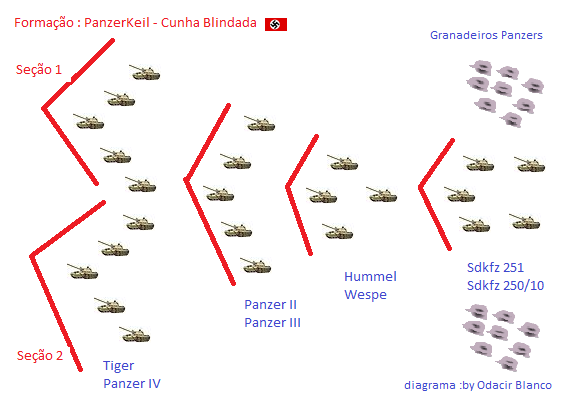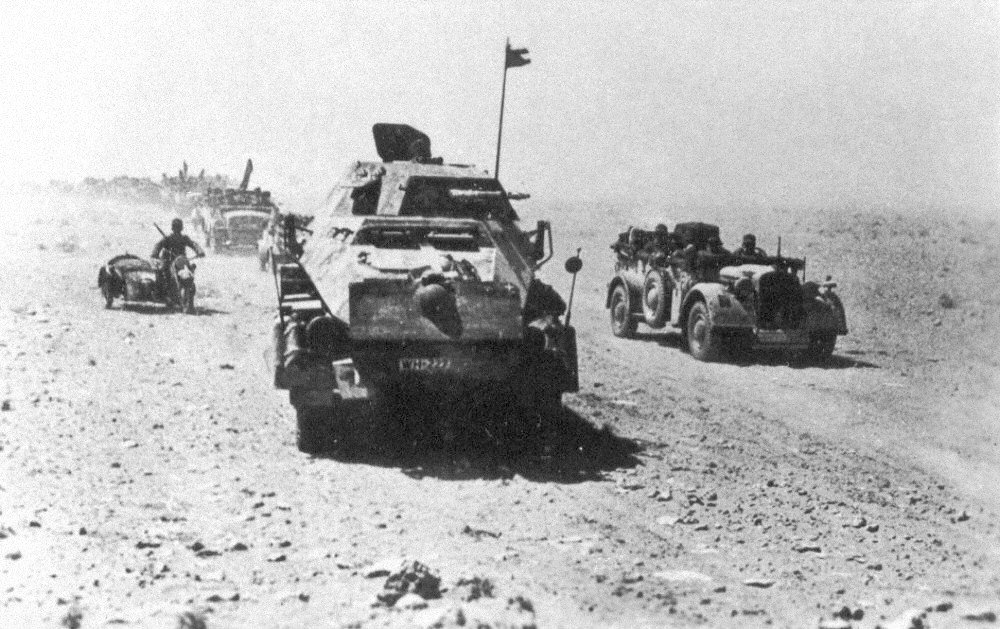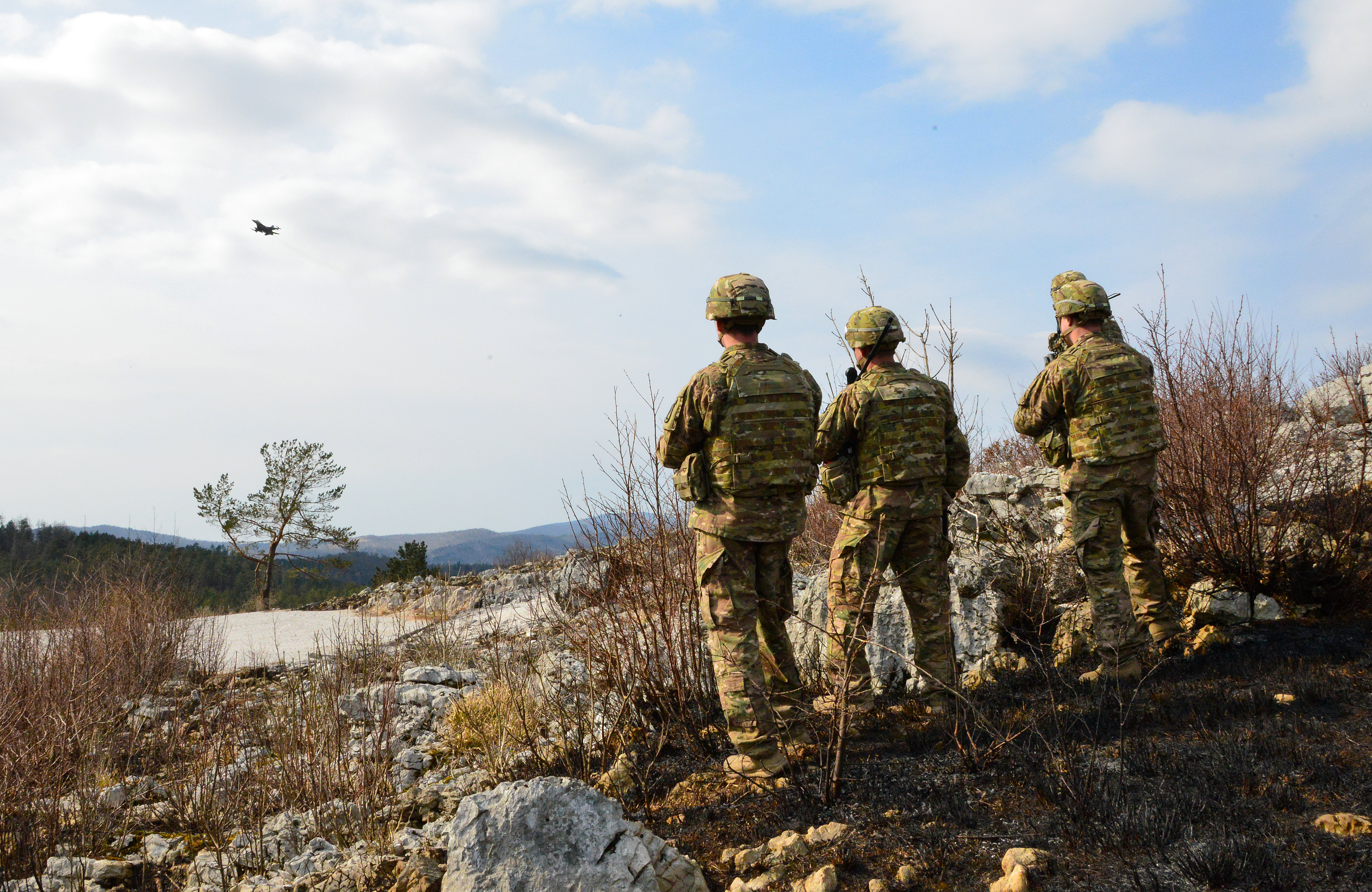|
Panzerkeil
The Panzerkeil ("armoured wedge" or "tank wedge") was an offensive armoured tactic developed by German ''Kampfgruppe'' (battle groups) on the Eastern Front during World War II. The ''Panzerkeil'' was developed in response to the Soviet employment of the ''Pakfront'' anti-tank gun defence. Usage The ''Panzerkeil'' was an offensive formation used by armoured vehicles, most commonly tanks, supported by ''Panzergrenadier'' mechanised infantry and aircraft. The tanks would form into a wedge-shaped formation, with the most heavily armed and armoured vehicles forming the tip. At the Battle of Kursk, Tiger I heavy tanks would form the tip, Panther medium tanks (where available) the base, with Panzer IV and Panzer III medium tanks forming the wings. The advantage of the ''Panzerkeil'' was that the anti-tank gunners of the opposing ''Pakfront'' would be forced to constantly adjust their ranges due to the depth of the formation. Also, the heavily armoured Tigers and Panthers would bear ... [...More Info...] [...Related Items...] OR: [Wikipedia] [Google] [Baidu] |
Pakfront
The Pakfront was a defensive military tactic developed by the German forces on the Eastern Front during the Second World War. It was named after the phonetic pronunciation of the acronym nomenclature for German towed anti-tank guns, PaK (''PanzerabwehrKanone'', "tank defense cannon"). The Soviets soon copied the tactic, and used it to great effect at the Battle of Kursk in July 1943. German tactic During the large Soviet armoured attacks on the Eastern front in late 1941–1942, the Germans quickly realised that their anti-tank guns, operating individually or in small groups, and with no central commander, were quickly overwhelmed. The ''pakfront'' was developed to counter this. A group of up to ten guns were placed under the command of one officer. He was responsible for designating targets and directing the fire of his guns. This allowed the Germans to spring particularly effective anti-tank ambushes, with all guns being assigned separate targets and then firing at once, maxim ... [...More Info...] [...Related Items...] OR: [Wikipedia] [Google] [Baidu] |
Kampfgruppe
In military history, the German term (pl. ; abbrev. KG, or KGr in usage during World War II, literally "fighting group" or "battle group") can refer to a combat formation of any kind, but most usually to that employed by the of Nazi Germany and its allies during World War II and, to a lesser extent, of the German Empire in World War I. It also referred to bomber groups in ''Luftwaffe'' usage, which themselves consisted of three or four (squadrons), and usually (but not exclusively) existed within bomber wings of three or four per wing. Nature The ''Kampfgruppe'' was an ''ad hoc'' combined arms formation, usually employing a combination of tanks, infantry, and artillery (including anti-tank) elements, generally organised for a particular task or operation.While the word ''Kampfgruppe'' in German literally refers to any battle group, the modern usage in the English-speaking world is restricted to World War II. ''Kampfgruppen'' in World War I lacked the panzer com ... [...More Info...] [...Related Items...] OR: [Wikipedia] [Google] [Baidu] |
Walter Model
Otto Moritz Walter Model (; 24 January 1891 – 21 April 1945) was a German field marshal during World War II. Although he was a hard-driving, aggressive panzer commander early in the war, Model became best known as a practitioner of defensive warfare. His relative success as commander of the Ninth Army in the battles of 1941–1942 determined his future career path. Model first came to Hitler's attention before World War II, but their relationship did not become especially close until 1942. His tenacious style of fighting and loyalty to the Nazi regime won him plaudits from Hitler, who considered him one of his best field commanders and repeatedly sent him to salvage apparently desperate situations on the Eastern Front. Their relationship broke down by the end of the war after the German defeat at the Battle of the Bulge. In the aftermath of the encirclement and defeat of Army Group B at the Ruhr Pocket, Model committed suicide on 21 April 1945. Early life and career ... [...More Info...] [...Related Items...] OR: [Wikipedia] [Google] [Baidu] |
Assault Tactics
An assault is the act of committing physical harm or unwanted physical contact upon a person or, in some specific legal definitions, a threat or attempt to commit such an action. It is both a crime and a tort and, therefore, may result in criminal prosecution, civil liability, or both. Generally, the common law definition is the same in criminal and tort law. Traditionally, common law legal systems have separate definitions for assault and battery. When this distinction is observed, battery refers to the actual bodily contact, whereas assault refers to a credible threat or attempt to cause battery. Some jurisdictions combined the two offences into a single crime called "assault and battery", which then became widely referred to as "assault". The result is that in many of these jurisdictions, assault has taken on a definition that is more in line with the traditional definition of battery. The legal systems of civil law and Scots law have never distinguished assault from battery ... [...More Info...] [...Related Items...] OR: [Wikipedia] [Google] [Baidu] |
Armoured Spearhead
An armoured spearhead (American English: armored spearhead) is a formation of armoured fighting vehicles, mostly tanks, that form the front of an offensive thrust during a battle. The idea is to concentrate as much firepower into a small front as possible, so any defenders in front of them will be overwhelmed. As the spearhead moves forward, infantry units following in the gap behind them form up on either side of the line of advance in order to protect the flanks. The tactic is quite risky. A determined enemy can counterattack against the infantry on the flanks, thereby cutting off the spearhead from resupply and quickly bringing it to a halt. In order to avoid this the spearhead must move as fast as possible in order to keep the defense from re-organizing in this fashion . The first use of an armored spearhead was during World War II in the 1940 Battle of France, the German Army's invasion of the Low Countries, against the British and French armies . Surprising them out of th ... [...More Info...] [...Related Items...] OR: [Wikipedia] [Google] [Baidu] |
Flying Wedge
A flying wedge (also called flying V or wedge formation, or simply wedge) is a configuration created from a body moving forward in a triangular formation. This V-shaped arrangement began as a successful military strategy in ancient times when infantry units would move forward in wedge formations to smash through an enemy's lines. This principle was later used by Medieval European armies, as well as modern armed forces, which have adapted the V-shaped wedge for armored assault. In modern times the effectiveness of flying wedge means it is still employed by civilian police services for riot control. It has also been used in some sports, although the use of wedges is sometimes banned due to the danger it poses to defenders. Military tactics Antiquity Greeks and Romans The wedge (έμβολον, ''embolon'' in Greek; ''cuneus'' in Latin, colloquially also ''caput porcinum'', "boar's head"), was used by both infantry and cavalry. The men deployed in a triangular or trapezoid ... [...More Info...] [...Related Items...] OR: [Wikipedia] [Google] [Baidu] |
Bell
A bell is a directly struck idiophone percussion instrument. Most bells have the shape of a hollow cup that when struck vibrates in a single strong strike tone, with its sides forming an efficient resonator. The strike may be made by an internal "clapper" or "uvula", an external hammer, or—in small bells—by a small loose sphere enclosed within the body of the bell ( jingle bell). Bells are usually cast from bell metal (a type of bronze) for its resonant properties, but can also be made from other hard materials. This depends on the function. Some small bells such as ornamental bells or cowbells can be made from cast or pressed metal, glass or ceramic, but large bells such as a church, clock and tower bells are normally cast from bell metal. Bells intended to be heard over a wide area can range from a single bell hung in a turret or bell-gable, to a musical ensemble such as an English ring of bells, a carillon or a Russian zvon which are tuned to a common scale and inst ... [...More Info...] [...Related Items...] OR: [Wikipedia] [Google] [Baidu] |
Close-air Support
In military tactics, close air support (CAS) is defined as air action such as air strikes by fixed or rotary-winged aircraft against hostile targets near friendly forces and require detailed integration of each air mission with fire and movement of these forces and attacks with aerial bombs, glide bombs, missiles, rockets, autocannons, machine guns, and even directed-energy weapons such as lasers.''Close Air Support''. United States Department of Defense, 2014. The requirement for detailed integration because of proximity, fires or movement is the determining factor. CAS may need to be conducted during shaping operations with Special Operations Forces (SOF) if the mission requires detailed integration with the fire and movement of those forces. A closely related subset of air interdiction (AI), battlefield air interdiction, denotes interdiction against units with near-term effects on friendly units, but which does not require integration with friendly troop movements. The term ... [...More Info...] [...Related Items...] OR: [Wikipedia] [Google] [Baidu] |
Salient (military)
A salient, also known as a bulge, is a battlefield feature that projects into enemy territory. The salient is surrounded by the enemy on multiple sides, making the troops occupying the salient vulnerable. The opponent's front line that borders a salient is referred to as a re-entrant – that is, an angle pointing inwards. A deep salient is vulnerable to being "pinched off" through the base, and this will result in a pocket in which the forces in the salient become isolated and without a supply line. On the other hand, a breakout of the forces within the salient through its tip can threaten the rear areas of the opposing forces outside it, leaving them open to an attack from behind. Implementation Salients can be formed in a number of ways. An attacker can produce a salient in the defender's line by either intentionally making a pincer movement around the military flanks of a strongpoint, which becomes the tip of the salient, or by making a broad, frontal attack which is held u ... [...More Info...] [...Related Items...] OR: [Wikipedia] [Google] [Baidu] |
Anti-tank Mine
An anti-tank mine (abbreviated to "AT mine") is a type of land mine designed to damage or destroy vehicles including tanks and armored fighting vehicles. Compared to anti-personnel mines, anti-tank mines typically have a much larger explosive charge, and a fuze designed to be triggered by vehicles or, in some cases, remotely or by tampering with the mine. History First World War The first anti-tank mines were improvised during the First World War as a countermeasure against the first tanks introduced by the British towards the end of the war. Initially they were nothing more than a buried high-explosive shell or mortar bomb with its fuze upright. Later, purpose-built mines were developed, including the Flachmine 17, which was simply a wooden box packed with explosives and triggered either remotely or by a pressure fuze. By the end of the war, the Germans had developed row mining techniques, and mines accounted for 15% of U.S. tank casualties during the Battle of Saint-M ... [...More Info...] [...Related Items...] OR: [Wikipedia] [Google] [Baidu] |
Mobility Kill
A mobility kill (or M-kill) in armoured warfare is a weapon or vehicle that is immobilized, or the act of immobilizing such a target. This is often caused by the vehicle triggering an anti-tank mine by driving over it, though it may also result from being hit by a rocket propelled grenade or anti-tank missile. Tanks and other armoured fighting vehicles can be immobilized by damage to their engines, tracks, or running gear. Because of the mobile nature of modern warfare, such a vehicle is often effectively useless on the battlefield, though it may later be salvaged for spares, or repaired and brought back into action. In rare cases, tanks that have suffered mobility kills have continued to engage enemy targets with their main gun, even though they are immobile. However, in an active battlefield situation any armoured fighting vehicles which have suffered mobility kills are stationary targets for ground-attack planes armed with ordnance such as rockets or cluster bombs. Alternative ... [...More Info...] [...Related Items...] OR: [Wikipedia] [Google] [Baidu] |
Combat Engineers
A combat engineer (also called pioneer or sapper) is a type of soldier who performs military engineering tasks in support of land forces combat operations. Combat engineers perform a variety of military engineering, tunnel and mine warfare tasks as well as construction and demolition duties in and out of combat zones. Combat engineers facilitate the mobility of friendly forces while impeding that of the enemy. They also work to assure the survivability of friendly forces, building fighting positions, fortifications, and roads. They conduct demolitions missions and clear minefields manually or through use of specialized vehicles. Common combat engineer missions include construction and breaching of trenches, tank traps and other obstacles and fortifications; obstacle emplacement and bunker construction; route clearance and reconnaissance; bridge and road construction or destruction; emplacement and clearance of land mines; and combined arms breaching. Typically, combat enginee ... [...More Info...] [...Related Items...] OR: [Wikipedia] [Google] [Baidu] |








